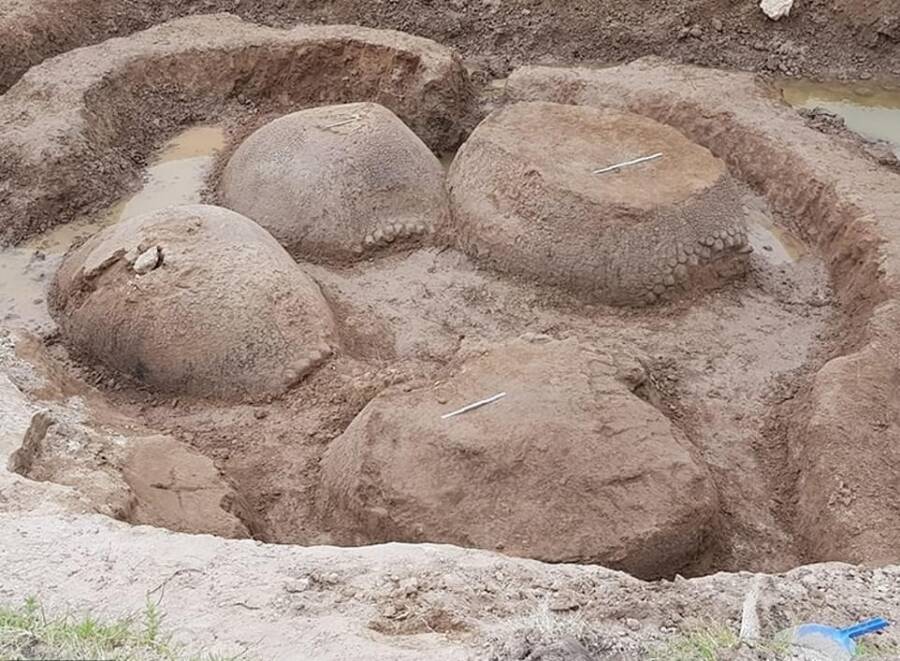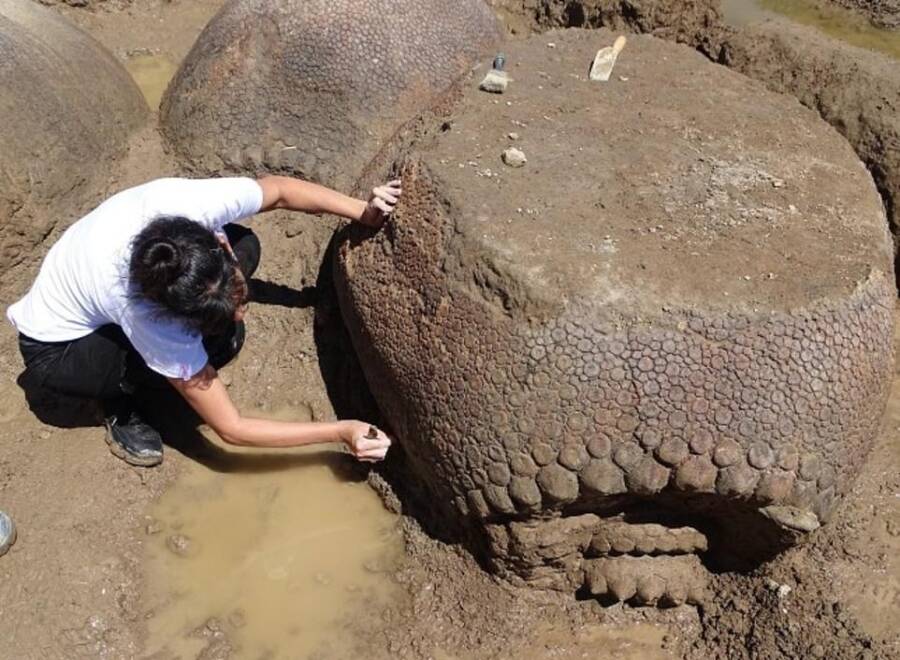It's believed that the giant armadillo species went extinct 10,000 years ago. This is the first time four of them have been found in the same spot.

INCUAPAThe farmer was shocked to find a family of ancient armadillos on his property.
An Argentinian farmer named Juan de Dios Sota was simply transporting his young cattle when he stumbled across something much older — a couple of 20,000-year-old giant armadillos.
Right beneath the farmer’s feet beside the dried riverbed of the Vallimanca stream, were the fossilized remains of four gigantic armadillos also known as Glyptodon.
The Institute of Archaeological and Paleontological Investigations of the Pampa Quaternary (INCUAPA) explained that a regional drought revealed the ancient specimens which had once been submerged in the river.
“We went there expecting to find two Glyptodonts when the excavation started and then two more were found!” Pablo Messino, an on-site archaeologist, told Daily Mail.
“It is the first time there have been four animals like this in the same site,” added Messino. “Most of them were facing the same direction like they were walking towards something.”
Experts wonder if perhaps the group represented a male and female parent leading their young, like a sort of nuclear family of ancient armadillos.

INCUAPAThese giant animals went extinct about 10,000 years ago.
For on-site paleontologist Ricardo Bonini, the discovery of these VW Beetle-sized specimens could help explain their ancient family structure. He wonders if perhaps the creatures experienced sexual dimorphism, meaning that the size of an individual armadillo would depend on its gender.
“These kinds of cases, in which several individuals together who died in the same circumstances, are really exceptional and undoubtedly will give us a lot of information about these enigmatic animals and will allow us to test several hypotheses that we have been driving in recent years,” he said.
Some of the ancient armadillos had shells as long as five feet and as thick as two inches.
According to INCUAPA, Glyptodon roamed South America for 30 million years before facing extinction around 10,000 years ago. Some believe early man was to blame for the animal’s disappearance by overusing their hard shells for shelter.

INCUAPAExperts are now eager to assess how and when these animals died, as well as to clarify whether they were sexually dimorphic or not.
As part of the Xenarthra (or Edentata) superorder of mammals, these hefty armadillo ancestors were staunch herbivores. A 2016 DNA test confirmed that Glyptodon were indeed related to modern-day armadillos — the latter of which means “little armored one” in Spanish.
These creatures naturally evolved an armored exterior to protect themselves against other animals, like an ancient, flightless, carnivorous bird known as the Terror Bird. Even areas not covered by the animal’s shell had bony deposits (osteoderms) as further safeguards.

Wikimedia CommonsThe animal’s protective shell is made of over 1,000 one-inch-thick bony plates called osteoderms.
The ancient armadillo’s tails, meanwhile, could be wielded as weapons with bony clusters at the end, sometimes even spikes.
This isn’t the first time a discovery like this was made in the region. In 2015, yet another Argentinian farmer found a three-foot-long shell belonging to a Glyptodon. Farmer Jose Antonio Nievas initially thought he discovered a dinosaur shell.
Ultimately, he stumbled upon something just as exciting — the remains of a specimen potentially as old as 30 million years.
As it stands, experts are forging ahead with further testing and are eager to assess just how old these armadillos were when they died, and how they met their end.
Next, read about the armadillo lizard — a mini-dragon that curls up like an armadillo. Then, learn about the Greek farmer who stumbled upon a 3,400-year-old Minoan tomb hidden under an olive grove.





